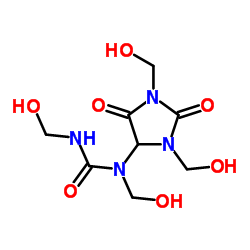Diazolidinyl urea

Diazolidinyl urea structure
|
Common Name | Diazolidinyl urea | ||
|---|---|---|---|---|
| CAS Number | 78491-02-8 | Molecular Weight | 278.219 | |
| Density | 1.8±0.1 g/cm3 | Boiling Point | 421.04°C (rough estimate) | |
| Molecular Formula | C8H14N4O7 | Melting Point | N/A | |
| MSDS | Chinese USA | Flash Point | N/A | |
| Symbol |

GHS07 |
Signal Word | Warning | |
Use of Diazolidinyl ureaDiazolidinyl urea, a broad spectrum preservative, is a formaldehyde-releasing compound that releases formaldehyde through its decomposition. Diazolidinyl urea is effective against most contaminating microorganisms, especially Pseudomonas[1][2]. |
| Name | Diazolidinyl urea |
|---|---|
| Synonym | More Synonyms |
| Description | Diazolidinyl urea, a broad spectrum preservative, is a formaldehyde-releasing compound that releases formaldehyde through its decomposition. Diazolidinyl urea is effective against most contaminating microorganisms, especially Pseudomonas[1][2]. |
|---|---|
| Related Catalog | |
| References |
| Density | 1.8±0.1 g/cm3 |
|---|---|
| Boiling Point | 421.04°C (rough estimate) |
| Molecular Formula | C8H14N4O7 |
| Molecular Weight | 278.219 |
| Exact Mass | 278.086243 |
| PSA | 153.88000 |
| LogP | -3.69 |
| Index of Refraction | 1.703 |
| InChIKey | SOROIESOUPGGFO-UHFFFAOYSA-N |
| SMILES | O=C1C(N(CO)C(=O)NCO)N(CO)C(=O)N1CO |
| Storage condition | 2-8°C |
| Stability | Stable. Incompatible with strong oxidizing agents. |
CHEMICAL IDENTIFICATION
HEALTH HAZARD DATAACUTE TOXICITY DATA
|
| Symbol |

GHS07 |
|---|---|
| Signal Word | Warning |
| Hazard Statements | H317 |
| Precautionary Statements | P280 |
| Personal Protective Equipment | dust mask type N95 (US);Eyeshields;Faceshields;Gloves |
| Hazard Codes | Xi:Irritant |
| Risk Phrases | R43 |
| Safety Phrases | S36/37 |
| RIDADR | NONH for all modes of transport |
| WGK Germany | 2 |
| RTECS | YS2717000 |
| HS Code | 2933990090 |
| HS Code | 2933990090 |
|---|---|
| Summary | 2933990090. heterocyclic compounds with nitrogen hetero-atom(s) only. VAT:17.0%. Tax rebate rate:13.0%. . MFN tariff:6.5%. General tariff:20.0% |
|
Non-fragrance allergens in specific cosmetic products.
Contact Dermatitis 65(5) , 276-85, (2011) Reports about the nature of the ingredients responsible for allergic contact dermatitis caused by specific cosmetic products are scarce.Between January 2000 and December 2010, the specific cosmetic pr... |
|
|
Investigation on formaldehyde release from preservatives in cosmetics.
Int. J. Cosmet. Sci. 37 , 474-8, (2015) To understand formaldehyde residue in cosmetics, an investigation on formaldehyde release from eight preservatives (methenamine - MA, paraformaldehyde - PF, poly(p-toluenesulfonamide-co-formaldehyde) ... |
|
|
Hand dermatitis: a focus on allergic contact dermatitis to biocides.
Dermatol. Clin. 27(3) , 251-64, v-vi, (2009) Hand dermatitis is a common disease of the skin resulting in significantly decreased quality of life. Allergic contact dermatitis is a frequent cause of hand dermatitis. Recent studies have revealed t... |
| 1-[1,3-Bis(hydroxymethyl)-2,5-dioxoimidazolidin-4-yl]-1,3-bis(hydroxymethyl)urea |
| Diazolidinylurea |
| N-[1,3-Bis(hydroxymethyl)-2,5-dioxo-4-imidazolidinyl]-N,N'-bis(hydroxymethyl)urea |
| Diazolidinyl urea |
| MFCD00079129 |
| urea, diazolidinyl |
| EINECS 278-928-2 |
| 1-[1,3-Bis(hydroxymethyl)-2,5-dioxo-4-imidazolidinyl]-1,3-bis(hydroxymethyl)urea |
| Urea, N-[1,3-bis(hydroxymethyl)-2,5-dioxo-4-imidazolidinyl]-N,N'-bis(hydroxymethyl)- |

